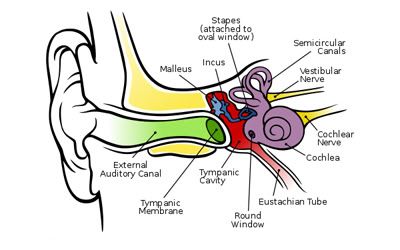 Not only does hearing allow us to experience the sounds around us, but it plays a major role in the development of speech. Children with Down syndrome can have a variety of hearing issues, both congenital and acquired, which if not treated can lead to greater problems.
Not only does hearing allow us to experience the sounds around us, but it plays a major role in the development of speech. Children with Down syndrome can have a variety of hearing issues, both congenital and acquired, which if not treated can lead to greater problems.Congenital disorders of the ear generally involve a sensorineural issue (whereby the sensory information is not transmitted or received by the auditory nerve properly). Often this involves the higher tones and is therefore not discovered until later on (as the child would continue to hear many of the sounds around them) and would therefore impact on their development (especially with speech). Routine screening allows for the discovery of congenital ear disorders. Down syndrome may affect any or all of the structures in the middle and inner ear.
Acquired hearing disorders can be divided into two categories: conductive hearing loss and sensorineural hearing loss. These can occur separately or together; many children with Down syndrome have a mixture of both.
A build up of cerumen (ear wax) can easily interfere with the functioning of the eardrum. If mobility of the eardrum is decreased, the sounds transmitted to the middle ear will be decreased as well. This is easily treated by a variety of measures including drops and suction removal by a qualified professional.
Those with Down syndrome can be more susceptible to more infections than the general population and as a result have a higher incidence of ear infections. Over time and especially if left untreated, these infections can cause damage. Fluid buildup in the middle ear, a ruptured tympanic membrane (eardrum) and difficulties with the ossicles can all result from infection.
As well, a condition commonly referred to as "glue ear" can develop. Sticky mucus can accumulate in the middle ear which can literally encase the ossicles and prevent them from vibrating (and therefore, transmitting sound). People with DS can produce more or stickier "glue" which frequently becomes infected as it does not drain away. Further hindering drainage is overall smaller Eustachian tubes in those with Down syndrome as well as the tendency for these tubes to be sharply curved.
With both of these conditions, antibiotics are most often prescribed. If the fluid or glue buildup is persistent, the child may have to undergo a tympanostomy and have "tubes" or grommets placed in the eardrum to allow the fluid to drain away.
As with any potential problem, early intervention is the key. Have your child assessed early by a trained audiologist and your medical team to prevent and minimize the chances of long term hearing loss.
"Anatomy of the Human Ear" shared with permission by Perception Space-The Final Frontier, A PLoS Biology Vol. 3, No. 4, e137 doi:10.1371/journal.pbio.0030137. Creative Commons.

No comments :
Post a Comment
Thank you for your comment.
Although discussion is encouraged, disrespectful or hurtful dialogue will be removed.
Spam will be fried up with a side of tomatoes.